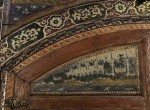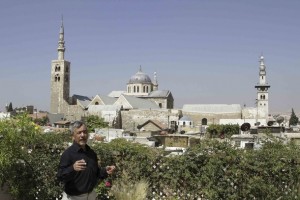French engineer and avid restorer Jacques Montlucon bought a small but lovely classic courtyard home in Old Damascus six years ago. These old aristocratic homes are fading fast in the Syrian capital, and Montlucon has a yen to save as many as he can. This particular property caught his eye because of its beautiful fountain and its dazzling rooftop view of the Umayyad mosque.
 He didn’t expect to find entirely unique wall paintings and stone carvings behind layers of varnish and 20th century tiles, however.
He didn’t expect to find entirely unique wall paintings and stone carvings behind layers of varnish and 20th century tiles, however.
“I was removing the heavy varnish covering the wood-paneled walls in the iwan (reception room) when figures of painted strange birds, monsters and castles started to emerge,” he said, pointing to the fine drawing between the carved wood.
“The paintings are dated 1789, the year of the French Revolution. But who knows how long it had taken for the news to travel from Paris to Syria,” he said.
An imaginary black bird pulls a boat. A man points a rifle from the top of a castle on a sea and monsters fly over the water. The wood ceiling resembles an intricate Persian carpet.[…]
Behind plain 20th century tiles in the same room, Montlucon also uncovered carved stone walls with mosaic-like Arab patterns, a technique pioneered by the Mamluks, one of the many rulers of Damascus.
Syrian craftsmen had a reputation for carving stone as if they were cutting paper. They flourished during Ottoman rule from the 16th to early 20th century, and incorporated Persian and Western influences, such as baroque into their work.
The thing that makes these extraordinary decorative elements unique is their theme. Other historical homes in Old Damascus have similar paintings, but they’re of buildings and landscapes. The fantastical, mythological paintings Montlucon found are unheard of in other courtyard homes.
Montlucon thinks the owners who covered up all this magnificence might have been hiding opulence from the piercing gaze of tax collectors, or they could have just wanted to modernize. I find it hard to imagine someone thinking layers of varnish were more stylish than exquisite 18th c. paintings, or that some spackle and tile cut a more handsome figure than hand-carved stone mosaic patterns, but crazy is as crazy does, I suppose.
At least Montlucon has a properly reverent attitude towards preserving the beauty he uncovered. He made sure to use the mildest of restoration techniques: nothing more than cotton balls, water colors and basic solvents. It took him and a friend 6 months to reveal the full majesty of his walls.
